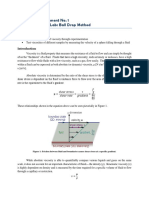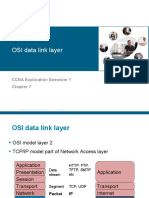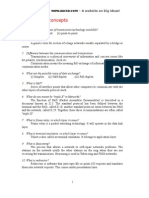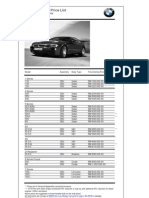Data Link Layer: Network Fundamentals - Chapter 7
Uploaded by
Rivandy HsData Link Layer: Network Fundamentals - Chapter 7
Uploaded by
Rivandy HsDATA LINK LAYER
Network Fundamentals Chapter 7
2007 Cisco Systems, Inc. All rights reserved.
Cisco Public
1. Accessing The Media
Supporting & Connecting to Upper Layer Services
The Data Link layer performs two basic services:
Allows the upper layers to access the media using techniques
such as framing
Controls how data is placed onto the media and is received
from the media using techniques such as media access control
and error detection
responsible for the exchange of frames between nodes over the
media of a physical network.
2007 Cisco Systems, Inc. All rights reserved.
Cisco Public
1. Accessing The Media
2007 Cisco Systems, Inc. All rights reserved.
Cisco Public
1. Accessing The Media
Supporting & Connecting to Upper Layer Services
Upper Layer Access to Media
he Data Link layer relieves the upper layers from the
responsibility of putting data on the network and receiving data
from the network
This layer provides services to support the communication
processes for each medium over which data is to be
transmitted.
At each hop along the path, an intermediary device accepts
frames from a medium, decapsulates the frame, and then
forwards the packet in a new frame appropriate to the medium
of that segment of the physical network
2007 Cisco Systems, Inc. All rights reserved.
Cisco Public
1. Accessing The Media
2007 Cisco Systems, Inc. All rights reserved.
Cisco Public
1. Accessing The Media
Controlling Transfer Across Local Media
Layer 2 protocols specify the encapsulation of a packet into a
frame and the techniques for getting the encapsulated packet on
and off each medium.
The technique used for getting the frame on and off media is
called the media access control method.
For the data to be transferred across a number of different media,
different media access control methods may be required during
the course of a single communication
The media access control methods described by the Data Link
layer protocols define the processes by which network devices can
access the network media and transmit frames in diverse network
environments.
A node that is an end device uses an adapter to make the
connection to the network
2007 Cisco Systems, Inc. All rights reserved.
Cisco Public
2007 Cisco Systems, Inc. All rights reserved.
Cisco Public
1. Accessing The Media
Creating A Frame
Data Link layer protocols require control information to enable the
protocols to function.
Control information may tell:
Which nodes are in communication with each other
When communication between individual nodes begins and
when it ends
Which errors occurred while the nodes communicated
Which nodes will communicate next
2007 Cisco Systems, Inc. All rights reserved.
Cisco Public
1. Accessing The Media
Creating A Frame
Data Link layer frame includes:
Data - The packet from the Network layer
Header - Contains control information, such addressing, and is
located at the beginning of the PDU
Trailer - Contains control information added to the end of the
PDU
2007 Cisco Systems, Inc. All rights reserved.
Cisco Public
1. Accessing The Media
Creating A Frame
Formatting Data for Transmission
When data travels on the media, it is converted into a stream of
bits, or 1s and 0s
Framing breaks the stream into decipherable groupings, with
control information inserted in the header and trailer as values
in different fields.
Typical field types include:
Start and stop indicator fields - The beginning and end limits
of the frame
Naming or addressing fields
Type field - The type of PDU contained in the frame
Quality - control fields
A data field -The frame payload (Network layer packet)
2007 Cisco Systems, Inc. All rights reserved.
Cisco Public
10
1. Accessing The Media
2007 Cisco Systems, Inc. All rights reserved.
Cisco Public
11
1. Accessing The Media
Connecting Upper Layer Services to the Media
The Data Link layer exists as a connecting layer between the
software processes of the layers above it and the Physical layer
below it
It prepares the Network layer packets for transmission across
some form of media
2007 Cisco Systems, Inc. All rights reserved.
Cisco Public
12
1. Accessing The Media
2007 Cisco Systems, Inc. All rights reserved.
Cisco Public
13
1. Accessing The Media
Data Link Sublayers
Divided into two sublayer to support a wide variety of network
functions
The upper sublayer defines the software processes that provide
services to the Network layer protocols.
The lower sublayer defines the media access processes
performed by the hardware.
Separating the Data Link layer into sublayers allows for one type
of frame defined by the upper layer to access different types of
media defined by the lower layer.
2007 Cisco Systems, Inc. All rights reserved.
Cisco Public
14
1. Accessing The Media
The two common LAN sublayers
Logical Link Control
Logical Link Control (LLC) places information in the frame that
identifies which Network layer protocol is being used for the
frame. This information allows multiple Layer 3 protocols, such
as IP and IPX, to utilize the same network interface and media.
Media Access Control
Media Access Control (MAC) provides Data Link layer
addressing and delimiting of data according to the physical
signaling requirements of the medium and the type of Data Link
layer protocol in use.
2007 Cisco Systems, Inc. All rights reserved.
Cisco Public
15
1. Accessing The Media
2007 Cisco Systems, Inc. All rights reserved.
Cisco Public
16
1. Accessing The Media
Standard
2007 Cisco Systems, Inc. All rights reserved.
Cisco Public
17
2. Media Access Control Techniques
Placing Data on The Media
Regulating the placement of data frames onto the media is known
as media access control
Among the different implementations of the Data Link layer
protocols, there are different methods of controlling access to the
media.
There are different ways to regulate the placing of frames onto the
media.
The protocols at the Data Link layer define the rules for access to
different media
The method of media access control used depends on:
Media sharing - If and how the nodes share the media
Topology - How the connection between the nodes appears to
the Data Link layer
2007 Cisco Systems, Inc. All rights reserved.
Cisco Public
18
2. Media Access Control Techniques
2007 Cisco Systems, Inc. All rights reserved.
Cisco Public
19
2. Media Access Control Techniques
Media Access Control on Shared Media
Some network topologies share a common medium with multiple
nodes.
At any one time, there may be a number of devices attempting to
send and receive data using the network media.
There are rules that govern how these devices share the media.
There are two basic media access control methods for shared
media:
Controlled - Each node has its own time to use the medium
Contention-based - All nodes compete for the use of the
medium
2007 Cisco Systems, Inc. All rights reserved.
Cisco Public
20
2. Media Access Control Techniques
Media Access Control on Shared Media
Controlled Access for Shared Media
Network devices take turns, in sequence, to access the
medium
If a device does not need to access the medium, the
opportunity to use the medium passes to the next device in line.
When one device places a frame on the media, no other
device can do so until the frame has arrived at the destination
and has been processed by the destination.
Inefficient because a device has to wait for its turn before it can
use the medium
2007 Cisco Systems, Inc. All rights reserved.
Cisco Public
21
2. Media Access Control Techniques
Media Access Control on Shared Media
2007 Cisco Systems, Inc. All rights reserved.
Cisco Public
22
2. Media Access Control Techniques
Media Access Control on Shared Media
Contention-based Access for Shared Media
allow any device to try to access the medium whenever it has
data to send
o prevent complete chaos on the media, these methods use a
Carrier Sense Multiple Access (CSMA) process to first detect if
the media is carrying a signal
If a carrier signal on the media from another node is detected, it
means that another device is transmitting.
When the device attempting to transmit sees that the media is
busy, it will wait and try again after a short time period. If no
carrier signal is detected, the device transmits its data.
CSMA is usually implemented in conjunction with a method for
resolving the media contention.
CSMA/CD
CSMA/CA
2007 Cisco Systems, Inc. All rights reserved.
Cisco Public
23
2. Media Access Control Techniques
Media Access Control on Shared Media
CSMA/Collision Detection
the device monitors the media for the presence of a data signal.
If a data signal is absent, indicating that the media is free, the
device transmits the data.
If signals are then detected that show another device was
transmitting at the same time, all devices stop sending and try
again later.
CSMA/Collision Avoidance
the device examines the media for the presence of a data
signal.
If the media is free, the device sends a notification across the
media of its intent to use it.
The device then sends the data.
2007 Cisco Systems, Inc. All rights reserved.
Cisco Public
24
2. Media Access Control Techniques
Placing Data on The Media
2007 Cisco Systems, Inc. All rights reserved.
Cisco Public
25
2. Media Access Control Techniques
Media Access Control on Non-Shared Media
Full Duplex and Half Duplex
In point-to-point connections, the Data Link layer has to
consider whether the communication is half-duplex or fullduplex
Half-duplex communication means that the devices can both
transmit and receive on the media but cannot do so
simultaneously
In full-duplex communication, both devices can transmit and
receive on the media at the same time.
2007 Cisco Systems, Inc. All rights reserved.
Cisco Public
26
2. Media Access Control Techniques
Full Duplex
2007 Cisco Systems, Inc. All rights reserved.
Cisco Public
27
2. Media Access Control Techniques
Half Duplex
2007 Cisco Systems, Inc. All rights reserved.
Cisco Public
28
2. Media Access Control Techniques
Logical Topology vs Physical Topology
The topology of a network is the arrangement or relationship of the
network devices and the interconnections between them.
Network topologies can be viewed at the physical level and the
logical level.
The physical topology is an arrangement of the nodes and the
physical connections between them
A logical topology is the way a network transfers frames from
one node to the next. This arrangement consists of virtual
connections between the nodes of a network independent of
their physical layout.
Logical and physical topologies typically used in networks are:
Point-to-Point
Multi-Access
Ring
2007 Cisco Systems, Inc. All rights reserved.
Cisco Public
29
2. Media Access Control Techniques
Point-to-Point
A point-to-point topology connects two nodes directly together.
In data networks with point-to-point topologies, the media access
control protocol can be very simple.
Logical Point-to-Point Networks
The end nodes communicating in a point-to-point network can be
physically connected via a number of intermediate devices.
However the use of physical devices in the network does not
affect the logical topology.
The media access method used by the Data Link protocol is
determined by the logical point-to-point topology, not the physical
topology.
2007 Cisco Systems, Inc. All rights reserved.
Cisco Public
30
2. Media Access Control Techniques
2007 Cisco Systems, Inc. All rights reserved.
Cisco Public
31
2. Media Access Control Techniques
2007 Cisco Systems, Inc. All rights reserved.
Cisco Public
32
2. Media Access Control Techniques
Multi-Access Topology
A logical multi-access topology enables a number of nodes to
communicate by using the same shared media.
Data from only one node can be placed on the medium at any one
time.
Every node sees all the frames that are on the medium, but only
the node to which the frame is addressed processes the contents
of the frame.
The media access control methods used by logical multi-access
topologies are typically CSMA/CD or CSMA/CA.
However, token passing methods can also be used.
2007 Cisco Systems, Inc. All rights reserved.
Cisco Public
33
2. Media Access Control Techniques
Multi-Access Topology
2007 Cisco Systems, Inc. All rights reserved.
Cisco Public
34
2. Media Access Control Techniques
Ring Topology
In a logical ring topology, each node in turn receives a frame.
If the frame is not addressed to the node, the node passes the
frame to the next node.
This allows a ring to use a controlled media access control
technique called token passing.
2007 Cisco Systems, Inc. All rights reserved.
Cisco Public
35
3. Media Access Control Addressing and Framing Data
2007 Cisco Systems, Inc. All rights reserved.
Cisco Public
36
3. Media Access Control Addressing and Framing Data
Framing Role of Header
Frame header contains the control information specified by the Data Link
layer protocol for the specific logical topology and media used.
Frame control information is unique to each type of protocol.
It is used by the Layer 2 protocol to provide features demanded by the
communication environment.
Typical frame header fields include:
Start Frame field - Indicates the beginning of the frame
Source and Destination address fields - Indicates the source and
destination nodes on the media
Priority/Quality of Service field - Indicates a particular type of
communication service for processing
Type field - Indicates the upper layer service contained in the frame
Logical connection control field - Used to establish a logical connection
between nodes
Physical link control field - Used to establish the media link
Flow control field - Used to start and stop traffic over the media
Congestion control field - Indicates congestion in the media
2007 Cisco Systems, Inc. All rights reserved.
Cisco Public
37
3. Media Access Control Addressing and Framing Data
Framing Role of Header
2007 Cisco Systems, Inc. All rights reserved.
Cisco Public
38
3. Media Access Control Addressing and Framing Data
Addressing Where the Frame Goes
2007 Cisco Systems, Inc. All rights reserved.
Cisco Public
39
3. Media Access Control Addressing and Framing Data
Framing Role of Trailer
The trailer is used to determine if the frame arrived without error.
This process is called error detection.
Error detection is accomplished by placing a logical or
mathematical summary of the bits that comprise the frame in the
trailer.
Frame Check Sequence (FCS)
Used to determine if errors occurred in the transmission and
reception of the frame.
The signals on the media could be subject to interference,
distortion, or loss that would substantially change the bit values
that those signals represent.
2007 Cisco Systems, Inc. All rights reserved.
Cisco Public
40
3. Media Access Control Addressing and Framing Data
Framing Role of Trailer
2007 Cisco Systems, Inc. All rights reserved.
Cisco Public
41
3. Media Access Control Addressing and Framing Data
Cyclic Redundancy Check
Cyclic redundancy check (CRC) is commonly used.
Sending node includes a logical summary of the bits in the frame.
Receiving node calculates its own logical summary, or CRC.
Compares the two CRC values.
Equal Accepts the frame
Different Discards the frame
2007 Cisco Systems, Inc. All rights reserved.
Cisco Public
42
3. Media Access Control Addressing and Framing Data
The Frame
2007 Cisco Systems, Inc. All rights reserved.
Cisco Public
43
3. Media Access Control Addressing and Framing Data
The Frame
Ethernet Protocol for LANs
Ethernet is a family of networking technologies that are defined
in the IEEE 802.2 and 802.3 standards.
Ethernet standards define both the Layer 2 protocols and the
Layer 1 technologies.
Ethernet is the most widely used LAN technology and supports
data bandwidths of 10, 100, 1000, or 10,000 Mbps.
2007 Cisco Systems, Inc. All rights reserved.
Cisco Public
44
Ethernet Protocol for LANs
2007 Cisco Systems, Inc. All rights reserved.
Cisco Public
45
3. Media Access Control Addressing and Framing Data
The Frame
Point-to-Point Protocol for WANs
Point-to-Point Protocol (PPP) is a protocol used to deliver
frames between two nodes.
PPP can be used on various physical media, including twisted
pair, fiber optic lines, and satellite transmission, as well as for
virtual connections.
To accommodate the different types of media, PPP establishes
logical connections, called sessions, between two nodes
2007 Cisco Systems, Inc. All rights reserved.
Cisco Public
46
3. Media Access Control Addressing and Framing Data
Point-to-Point Protocol
2007 Cisco Systems, Inc. All rights reserved.
Cisco Public
47
3. Media Access Control Addressing and Framing Data
The Frame
Wireless Protocol for LANs
802.11 is an extension of the IEEE 802 standards.
It uses the same 48-bit addressing scheme as other 802 LANs.
Contention-based system using a Carrier Sense Multiple
Access/Collision Avoidance (CSMA/CA)
2007 Cisco Systems, Inc. All rights reserved.
Cisco Public
48
3. Media Access Control Addressing and Framing Data
2007 Cisco Systems, Inc. All rights reserved.
Cisco Public
49
You might also like
- Asset Classes and Financial Instruments: Bodie, Kane, and Marcus Eleventh EditionNo ratings yetAsset Classes and Financial Instruments: Bodie, Kane, and Marcus Eleventh Edition48 pages
- LAB MANUAL. EXPERIMENT 1. Viscosity of Fluids (Ball Drop Method)33% (3)LAB MANUAL. EXPERIMENT 1. Viscosity of Fluids (Ball Drop Method)6 pages
- OSI Data Link Layer: Network Fundamentals - Chapter 7No ratings yetOSI Data Link Layer: Network Fundamentals - Chapter 721 pages
- Osi Data Link Layer: Network Fundamentals - Chapter 7 Sandra Coleman, CCNA, CCAINo ratings yetOsi Data Link Layer: Network Fundamentals - Chapter 7 Sandra Coleman, CCNA, CCAI23 pages
- OSI Data Link Layer: © 2006 Cisco Systems, Inc. All Rights Reserved. Cisco Public ITE I Chapter 6No ratings yetOSI Data Link Layer: © 2006 Cisco Systems, Inc. All Rights Reserved. Cisco Public ITE I Chapter 626 pages
- OSI Data Link Layer: CCNA Exploration Semester 1No ratings yetOSI Data Link Layer: CCNA Exploration Semester 120 pages
- OSI Data Link Layer: CCNA Exploration Semester 1No ratings yetOSI Data Link Layer: CCNA Exploration Semester 120 pages
- OSI Model: A Review: COM47L Engr. Jonai RepublicaNo ratings yetOSI Model: A Review: COM47L Engr. Jonai Republica32 pages
- OSI Data Link Layer: Network Fundamentals - Chapter 7No ratings yetOSI Data Link Layer: Network Fundamentals - Chapter 727 pages
- OSI Data Link Layer: Network Fundamentals - Chapter 7No ratings yetOSI Data Link Layer: Network Fundamentals - Chapter 730 pages
- Chapter 4 Data Link Layer (OSI Model)_July 2023No ratings yetChapter 4 Data Link Layer (OSI Model)_July 202339 pages
- Network Access: Introduction To Networks v5.1No ratings yetNetwork Access: Introduction To Networks v5.177 pages
- CCNA Exploration - Network Fundamentals 7 Data Link Layer 7.0 Chapter Introduction 7.0.1 Chapter IntroductionNo ratings yetCCNA Exploration - Network Fundamentals 7 Data Link Layer 7.0 Chapter Introduction 7.0.1 Chapter Introduction35 pages
- Ethernet: Network Fundamentals - Chapter 9No ratings yetEthernet: Network Fundamentals - Chapter 971 pages
- © 2003, Cisco Systems, Inc. All Rights ReservedNo ratings yet© 2003, Cisco Systems, Inc. All Rights Reserved76 pages
- Chapter - 02 - Communicating Over The NetworkNo ratings yetChapter - 02 - Communicating Over The Network30 pages
- Networking Concepts: Visit - A Website On Big Ideas!No ratings yetNetworking Concepts: Visit - A Website On Big Ideas!8 pages
- Network - Fundamentals Lecture 9 EthernetNo ratings yetNetwork - Fundamentals Lecture 9 Ethernet26 pages
- CCNA Certification/Data Link Layer: 0.1 Logical Link Control SublayerNo ratings yetCCNA Certification/Data Link Layer: 0.1 Logical Link Control Sublayer4 pages
- Network Fundamentals: Abdelkhalik Elsaid MosaNo ratings yetNetwork Fundamentals: Abdelkhalik Elsaid Mosa31 pages
- Ethernet: Network Fundamentals - Chapter 9No ratings yetEthernet: Network Fundamentals - Chapter 927 pages
- BCA TDC III TCP-IP Reference Model 2 by Dr. Rakesh RanjanNo ratings yetBCA TDC III TCP-IP Reference Model 2 by Dr. Rakesh Ranjan5 pages
- Microsoft PowerPoint - 98-366 Slides Lesson 2 (Modo de Compatibilidad) PDFNo ratings yetMicrosoft PowerPoint - 98-366 Slides Lesson 2 (Modo de Compatibilidad) PDF6 pages
- Brief Illustratio N of Food Hygiene Including The Food Safety CoursesNo ratings yetBrief Illustratio N of Food Hygiene Including The Food Safety Courses10 pages
- BMW Malaysia Price List: Model Assembly Body Type Total Selling PriceNo ratings yetBMW Malaysia Price List: Model Assembly Body Type Total Selling Price1 page
- Chapter One An Introduction To Human Capital ManagementNo ratings yetChapter One An Introduction To Human Capital Management13 pages
- Wilber, Ken - An Integral Theory of Consciousness (2001)No ratings yetWilber, Ken - An Integral Theory of Consciousness (2001)45 pages
- Ricardo Padilla Perez v. Secretary of Health & Human Services, 985 F.2d 552, 1st Cir. (1993)No ratings yetRicardo Padilla Perez v. Secretary of Health & Human Services, 985 F.2d 552, 1st Cir. (1993)10 pages
- Larry Klayman vs. Commie Girl Industries and Rebecca Schoenkopf Order To Dismiss100% (1)Larry Klayman vs. Commie Girl Industries and Rebecca Schoenkopf Order To Dismiss9 pages
- Lista de Verbos Regulares E Irregulares: TraducciónNo ratings yetLista de Verbos Regulares E Irregulares: Traducción7 pages
- The Linguistics of Second Language Acquisition: Sar BoNo ratings yetThe Linguistics of Second Language Acquisition: Sar Bo10 pages
- CISA Exam-Testing Concept-OSI Architecture (Domain-5)From EverandCISA Exam-Testing Concept-OSI Architecture (Domain-5)
- Asset Classes and Financial Instruments: Bodie, Kane, and Marcus Eleventh EditionAsset Classes and Financial Instruments: Bodie, Kane, and Marcus Eleventh Edition
- LAB MANUAL. EXPERIMENT 1. Viscosity of Fluids (Ball Drop Method)LAB MANUAL. EXPERIMENT 1. Viscosity of Fluids (Ball Drop Method)
- OSI Data Link Layer: Network Fundamentals - Chapter 7OSI Data Link Layer: Network Fundamentals - Chapter 7
- Osi Data Link Layer: Network Fundamentals - Chapter 7 Sandra Coleman, CCNA, CCAIOsi Data Link Layer: Network Fundamentals - Chapter 7 Sandra Coleman, CCNA, CCAI
- OSI Data Link Layer: © 2006 Cisco Systems, Inc. All Rights Reserved. Cisco Public ITE I Chapter 6OSI Data Link Layer: © 2006 Cisco Systems, Inc. All Rights Reserved. Cisco Public ITE I Chapter 6
- OSI Data Link Layer: Network Fundamentals - Chapter 7OSI Data Link Layer: Network Fundamentals - Chapter 7
- OSI Data Link Layer: Network Fundamentals - Chapter 7OSI Data Link Layer: Network Fundamentals - Chapter 7
- CCNA Exploration - Network Fundamentals 7 Data Link Layer 7.0 Chapter Introduction 7.0.1 Chapter IntroductionCCNA Exploration - Network Fundamentals 7 Data Link Layer 7.0 Chapter Introduction 7.0.1 Chapter Introduction
- Networking Concepts: Visit - A Website On Big Ideas!Networking Concepts: Visit - A Website On Big Ideas!
- CCNA Certification/Data Link Layer: 0.1 Logical Link Control SublayerCCNA Certification/Data Link Layer: 0.1 Logical Link Control Sublayer
- BCA TDC III TCP-IP Reference Model 2 by Dr. Rakesh RanjanBCA TDC III TCP-IP Reference Model 2 by Dr. Rakesh Ranjan
- Microsoft PowerPoint - 98-366 Slides Lesson 2 (Modo de Compatibilidad) PDFMicrosoft PowerPoint - 98-366 Slides Lesson 2 (Modo de Compatibilidad) PDF
- You Press 'Enter' on the Browser: What happens when..., #1From EverandYou Press 'Enter' on the Browser: What happens when..., #1
- Brief Illustratio N of Food Hygiene Including The Food Safety CoursesBrief Illustratio N of Food Hygiene Including The Food Safety Courses
- BMW Malaysia Price List: Model Assembly Body Type Total Selling PriceBMW Malaysia Price List: Model Assembly Body Type Total Selling Price
- Chapter One An Introduction To Human Capital ManagementChapter One An Introduction To Human Capital Management
- Wilber, Ken - An Integral Theory of Consciousness (2001)Wilber, Ken - An Integral Theory of Consciousness (2001)
- Ricardo Padilla Perez v. Secretary of Health & Human Services, 985 F.2d 552, 1st Cir. (1993)Ricardo Padilla Perez v. Secretary of Health & Human Services, 985 F.2d 552, 1st Cir. (1993)
- Larry Klayman vs. Commie Girl Industries and Rebecca Schoenkopf Order To DismissLarry Klayman vs. Commie Girl Industries and Rebecca Schoenkopf Order To Dismiss
- Lista de Verbos Regulares E Irregulares: TraducciónLista de Verbos Regulares E Irregulares: Traducción
- The Linguistics of Second Language Acquisition: Sar BoThe Linguistics of Second Language Acquisition: Sar Bo





























































































